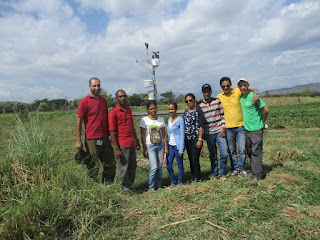So I hope from now on I can put a curve at least somewhere into every building I build. We are experimenting with a curved roof in the training centre for the main training room. My Timorese mate, Anen, somehow continues to take my crazy ideas in his stride and together we weld up a curved set of 'rafters' or roof members.
I was asked how I knew it would be strong enough. I replied that once it was built we would get up on top and jump around a bit and see if it wobbles. Its a non-technical approach but it might work.
My curved trusses are 200mm wide using 1" (25mm) gal steel water pipe. This was flexible enough to bend around in a curve by itself. 4 lengths are curved and welded to some zig-zag 10mm reo-bar steel. Then for the purlins that hold the roof sheeting, 2 C-channel 100mm steel lengths are welded together and slid in and attached to the 'trusses'. East Timor Roofing, in Baucau, kindly agreed to curve their zincalume sheeting to a 12m metre radius. The whole thing is a bit of a pig to put together but it is a bit fun.
The main training room getting a curved roof
I have been known to do dumber things in the past. We once built a dome sort of home out of straw bales. One of my many mistakes in that particular venture was that I sourced local straw bales from a soy bean farm.
Building our first home with curves - its basically a dome. On the left is a sleeping arch.
The fatal flaw was that there were small soy beans mixed within the bales. The mice thought these were very yummy and proceeded to eat our house. Drat.
It had a skylight using helicopter grade perspex. It was coated with local clay mixed with hydrated lime and Clarence river sand. Part of the house had a grass roof. We had solar panels and carried water from the river. Israel is about 2, and Serenity 8.







